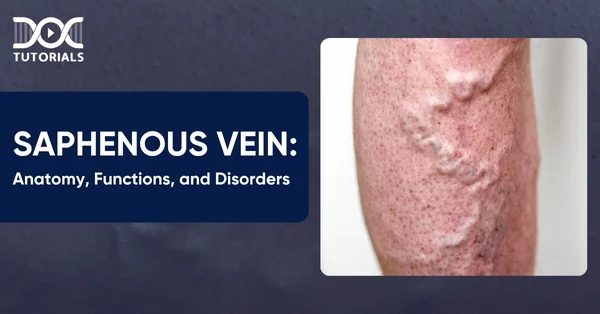Saphenous Vein: Anatomy, Functions, and Disorders

The superficial vein in your legs is made up of the saphenous vein, which collects blood with low oxygen levels from your foot and the smaller veins in your legs. The saphenous veins carry this blood to the deep veins, which then send it back to the heart. Conditions like varicose veins typically impact the saphenous veins, which need to be treated and cared for right away.
Read on to find out more about its type, structure, function, and disorders!
What is the Saphenous Vein?
People have saphenous veins in their legs. These veins are closer to the surface of your skin than the deep veins. There are two kinds of saphenous veins: great saphenous veins (GSV) and tiny saphenous veins (SSV).
The GSV goes from a person’s foot to their upper thigh, and the SSV goes from their foot to the back of their knee.
What is the Anatomy of the Saphenous Vein?
There are two main superficial veins in the lower limb that make up the saphenous vein: the great saphenous vein (GSV) and the small saphenous vein (SSV). Each has its own distinct courses and drainage patterns.
Here is a detailed overview:
The Great Saphenous Vein (GSV)
The GSV is the longest vein in the human body. It starts at the medial marginal vein of the dorsal venous arch of the foot. It goes from the front of the ankle to the medial malleolus, which is the bony bump on the inside of the ankle, and goes up the inside part of the leg and then along the back of the thigh.
This vein is a noticeable superficial vessel because it sits between the muscle fascia and the dermis. It gets tributaries from accessory saphenous veins as it rises and connects to deep veins through perforating branches.
The GSV goes through the saphenous opening (fossa ovalis) in the upper thigh, which is about 4 cm below and to the left of the pubic tubercle. It then joins the femoral vein at the saphenofemoral junction, along with other superficial veins like the superficial circumflex iliac, superficial epigastric, and external pudendal veins.
Small Saphenous Vein (SSV)
The small saphenous vein starts on the outside of the foot’s dorsal venous network. It goes through the subcutaneous tissue along the back of the calf and behind the lateral malleolus (outer ankle). The SSV then goes through the deep fascia in the popliteal fossa, which is behind the knee, and into the popliteal vein.
Along its path, the SSV connects to both the GSV and the deep venous system by a number of perforating veins. It helps blood flow back from the lower leg’s sides and back.
This difference in anatomy is very important for understanding how blood drains, how to treat venous problems, and how to manage them.
What are the Functions of the Saphenous Vein?
The saphenous veins are essential for your body’s circulatory system. This is how it works:
It helps get blood, that doesn’t have enough oxygen, back to your heart from your legs.
Many tiny veins in your feet and lower legs drain into the saphenous veins. These veins then send the blood up to the bigger veins in your upper legs.
After that, the blood keeps going until it gets to the inferior vena cava, a big vein that goes straight to your heart.
This is the part of the cycle that keeps your blood circulating about your body all the time. The circulatory system makes sure that blood is always circulating, bringing oxygen and important nutrients to every organ and tissue.
Role of Arteries and Veins
Arteries convey blood that is rich in oxygen out from the heart. Meanwhile, veins, such as the saphenous veins, carry blood that is low in oxygen back to the heart. Blood has to always go back to the heart because the heart sends it to the lungs, where it picks up fresh oxygen and releases carbon dioxide.
Once re-oxygenated, the blood returns to the heart, which then pumps it out to nourish the body again. After delivering oxygen and nutrients, the blood enters the veins to begin its return trip, and this cycle repeats continuously.
Other Functions of Saphenous Veins
Saphenous veins are important for more than just circulation; they are also crucial for several medicinal operations. Surgeons often utilise a piece of the saphenous vein to make a new conduit for blood to flow around a blocked coronary artery during coronary artery bypass grafting (CABG).
This helps get blood flowing properly to the heart muscle again. Researchers are still looking at how well the saphenous vein works in the long run and how it compares to other possibilities for bypass grafts. So, the saphenous veins are not only important for everyday blood flow, but they are also useful in surgeries that save lives.
What are the Common Disorders of the Saphenous Vein?
Issues with the veins in a person’s legs are the main things that impact the saphenous veins. These kinds of problems make it harder for your veins to do their jobs. Here is a detailed overview:
Venous Insufficiency
When the valves of the great saphenous vein (GSV) get weak or broken, blood flows backward instead of up towards the heart. Chronic venous insufficiency (CVI) is caused by this backward flow, or reflux. Some symptoms are swelling in the legs, a sense of heaviness or pain, skin discolouration, and the appearance of varicose veins.
Varicose Veins
Enlarged, twisted veins that are just under the skin are called varicose veins. They are generally caused by valve failure, which puts more pressure on the saphenous veins. You can see them as bulging, rope-like shapes, mainly on the legs. Leg pain, burning, cramping, itching, or inflammation around the afflicted veins are all possible symptoms.
Superficial Thrombophlebitis
This condition causes inflammation and clots to form in the saphenous vein’s superficial veins. It causes redness, warmth, discomfort, and mild swelling along the path of the afflicted vein. This condition is not as deadly as deep vein thrombosis, but it can still be very painful and needs medical attention.
Deep Vein Thrombosis (DVT) Risk
If superficial vein problems are left untreated, they may increase the risk of developing DVT, a serious condition where a blood clot forms in a deep vein, often in the leg. DVT can lead to life-threatening complications like pulmonary embolism if the clot dislodges and travels to the lungs.
FAQs About the Saphenous Vein
- What is the purpose of using the saphenous vein in bypass surgery?
The saphenous veins are the right size, easy to get to, and long enough to construct new blood flow channels during coronary artery bypass grafting.
- How do doctors manage problems with the saphenous vein?
The severity of the saphenous vein issue will determine how it is treated. It includes modifications to your lifestyle, compression therapy, sclerotherapy, endovenous laser therapy, and surgery.
- How much blood do the saphenous veins send back?
The great and small saphenous veins work together to send roughly 10% of the blood from the legs back to the heart.
Conclusion
Saphenous veins aid blood flow back to the heart by collecting it from the veins in the legs and sending it to the deep veins. Medical students need to know this vein’s anatomy, course, function, and related complications.
With DocTutorial’s guidance and professional assistance, you can get the best preparation for your NEET PG exam. We provide one-to-one problem-solving, video-recorded lectures, and detailed study materials and arrange timely assessments to monitor your progress and improvement.For the latest updates on our NEET PG course, please contact us today!
Latest Blogs
-

NEET PG Exam 2025- Date, Pattern, Marking Scheme, Subject Wise Weightage, and Exam Mode
NEET PG Exam 2025 is the ultimate gateway for medical graduates aspiring to pursue postgraduate courses in medicine, including MD,…
-

INI CET Exam 2025: Your Roadmap to Success – Key Topics, Strategies, and Lessons from Last Year’s Papers
The INI CET exam is more than just a test; it’s a significant milestone for many medical students aiming to…
-

INI CET Exam Success: Previous Year Question Papers & Ultimate Guide – INI CET PYQ
One can feel overwhelmed while preparing for the INI CET (Institute of National Importance Combined Entrance Test). A vast syllabus,…




